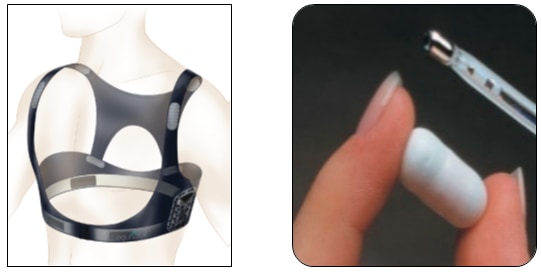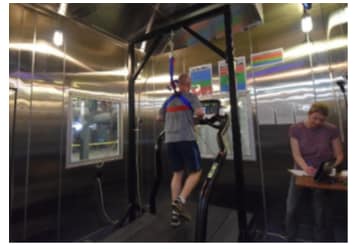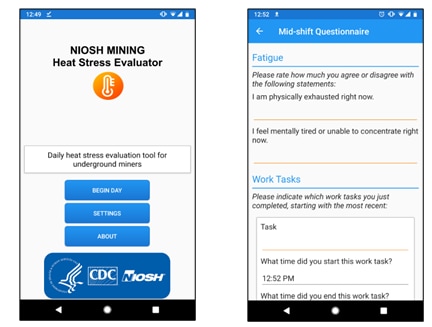Mining Project: Predicting the Impact of Heat Strain on Cognitive Functions in Miners
| Principal Investigator |
|
|---|---|
| Start Date | 10/1/2017 |
| Objective |
Heat strain is a growing problem in underground and surface mining as mines expand into deeper and hotter environments and heat waves increase in frequency, length, and intensity. The impacts of heat strain on health and safety may depend on the frequency, duration, and intensity of heat exposure. One of the known impacts of heat strain is worker injuries, with multiple studies demonstrating associations between heat exposure and work injuries. Mitigating the effects of heat strain on injuries is an important step in improving miner health and safety. Because one of the likely contributing factors to heat-related injuries is cognitive decline, a better understanding of when cognitive decline occurs is essential to mitigating the serious consequences of heat strain. Understanding individual variability in physiologic and cognitive responses to heat exposure is also important to avoid using a “one-size-fits-all” approach to mitigating heat strain. In this project, researchers aim to determine the extent of risk that miners face from heat-induced cognitive impairment and how to quantify that risk. Researchers will assess whether there are physiologic thresholds at which cognitive performance begins to decline, identify the factors that contribute to variability in individual responses to heat, and assess patterns (i.e., intensity, duration, and frequency) of heat strain among U.S. miners. |
| Topic Area |
Research Summary
Approach
This project is a dual-arm study with observational field and interventional environmental chamber components to evaluate the effects of heat exposure on cognitive function. For the field component, mine workers will ingest a temperature capsule and wear a bio-harness to measure core body temperature and heart rate while performing their normal activities during two shifts. Workers will complete a cognitive assessment twice during each shift based on perception of body temperature—once with a perceived normal body temperature and once with a perceived elevated body temperature.
In the environmental chamber, research participants will complete exercise testing using alternating resistance and aerobic exercises with real-time heart rate and core body temperature monitoring in environmental conditions set to room temperature (i.e., control) as well as hot conditions (i.e., 100°F and 80% humidity). Cognitive tests will be administered at a normal baseline body temperature and when core body temperature reaches an elevated threshold.
Milestones and Accomplishments
| Description | Audience | Year |
|---|---|---|
| Completed pilot studies in the field and environmental chamber to identify heat-sensitive cognitive tests and refine research protocol | NIOSH investigators, academia |
2019 |
| Developed heat stress app to conduct cognitive assessments of miners when body temperature is elevated | NIOSH investigators, academia | 2021-2023 |
| Developed heat stress fact sheets | Health and safety professionals at mining operations | 2017 |
| Published online heat stress training module | Health and safety professionals and miners at mining operations | 2023 |
Planned Impacts and Outcomes
The research will inform industry-wide efforts to mitigate large-scale BEV fires and explosions. Thermal runaway experiments will be designed to determine if explosion-proof enclosure assessment criteria should be enhanced to mitigate excessive over-pressures and temperatures. A thermal stability study will determine at which temperature exothermic reactions can be initiated in battery cells used for underground BEVs, with these findings being useful for battery thermal management. The investigation of gas analysis methods will inform longer-term research to mitigate health and safety risks of gasses released by battery fires. A comprehensive literature review on Mine Safety and Health Administration (MSHA) requirements and standards used by other industries will identify potential knowledge gaps of impacts, vibrations, and other environmental conditions that underground BEVs are subjected to.
Outputs
Mallett L, Connor B, Yeoman K, Victoroff T, Poplin G, DuBose W, Bauerle T [2023]. Keeping cool: training to reduce heat stress incidents. U.S. Department of Health and Human Services, Public Health Service, Centers for Disease Control and Prevention, National Institute for Occupational Safety and Health.
Johnson A, Yeoman K, Eiter B [2022]. Keys to protecting mine workers from heat stress. Pit and Quarry Aug 2022.
Victoroff T, Yeoman K [2017]. Heat stress: a series of fact sheets for promoting safe work in hot mining settings. U.S. Department of Health and Human Services, Public Health Service, Centers for Disease Control and Prevention, National Institute for Occupational Safety and Health.
Yeoman K, Bauerle T, Dubose W, Finley S, Poplin, G, Victoroff T [2020]. Patterns of heat strain among a sample of US underground miners. J Occup Environ Med 61(3):212-218.
Yeoman K, Weakley A, DuBose W, Eiter B, Poplin G, Hohn K, McMurry T, Baker B [2022]. Effects of heat strain on cognitive function among a sample of miners. App Ergon 102:1-9.
Related Resources
Heat Stress: A Series of Fact Sheets for Promoting Safe Work in Hot Mining Settings (six downloadable fact sheets)
A Study of Heat Stress Exposures and Interventions for Mine Rescue Workers (conference paper)
Patterns of Heat Strain Among a Sample of US Underground Miners (peer-reviewed journal article)
CDC - Mining - Keeping Cool Training to Reduce Heat Stress Incidents (training module)
Heat Stress (NIOSH topic page)
Supporting Visuals
Chest harnesses and ingestible temperature pills will be used to collect heart rate and core body temperature data during the field and environmental components. This information will allow NIOSH investigators to understand the effects of elevated core body temperatures on cognitive function.
In the environmental chamber, participants will follow an exercise protocol that will stimulate core body temperature to rise. Cognitive tests will be conducted when core body temperatures reach specified thresholds.
In the field study, participants will use a smart phone to take a cognitive test when they perceive that body temperatures are normal and again when they perceive that body temperatures are elevated.


